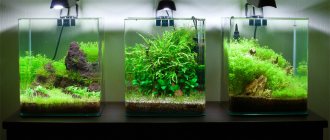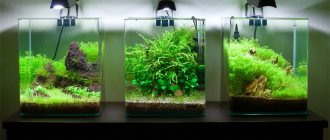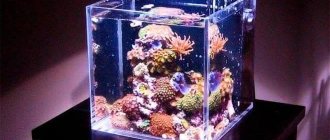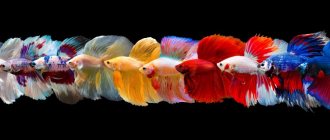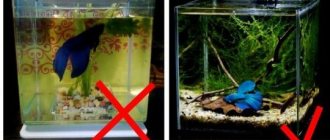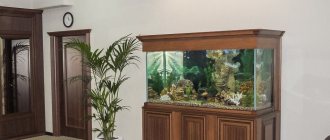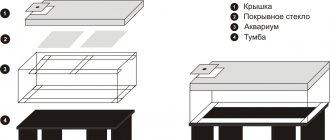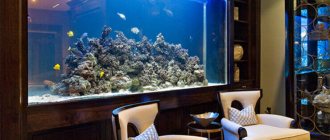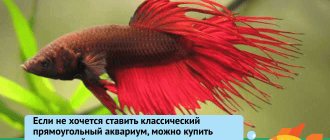Nano aquarium or all about cubes
Nano aquarium is a collective image with which aquarists have dubbed a whole galaxy of aquariums with a volume of 5 to 30 liters, of various shapes: round, square, rectangular!
In this article, we will demonstrate examples of the design of a nano-cube, and also talk about which nano-aquarium is better, how to start it, what fish and plants can be kept in such a volume.
So let's start by visualizing the subject of the conversation. For this review, we chose the aquarium set Gloxy Optic Set-27, 30x30x30cm.
Orizias
Representatives of this genus of fish, which includes about 30 species, are rightfully considered one of the smallest.
These crumbs, 1.5-2 cm in size, came into aquariums from the Mekong River basin. They are not brightly colored. In contrast, the grayish coloration with shades of pale yellow is unremarkable.
How can they interest fans of nanoaquariums?
- Firstly, they produce very viable offspring. Apparently, natural living conditions contributed to the development of a strong immune system.
- Secondly, after spawning, female orysias retain the eggs under their belly. Connected with the finest threads, the eggs hang under the female’s belly for a long time. She just floats with these original “grapes”.
The fish is quite unpretentious and feels good in a wide temperature range: from +17 to +22 °C. The water must be neutral in both pH balance and hardness.
The peaceful orysias feeds on dry food, as well as daphnia and brine shrimp. The lifespan in an aquarium can reach 3 years.
Orysias blue.
Description
The meaning of the word “nano” is known to many. Thinking about nanotechnology, you can understand that it means something small. The idea to create a microcosm arose when aquarists tried to make marine reef aquariums smaller. As a rule, in order to recreate a full-fledged marine picture, with anemones, living corals, various invertebrates and marine fish species, a large capacity container is needed. However, over time, aquariums smaller than 300 liters began to appear, which acquired the name “micro-reefs”. Models smaller than 100 liters began to be called “nano reefs”.
Now, the prefix “nano” means a freshwater aquarium, the volume of which is 35 liters or less. Although the name does not indicate the volume itself, but the ability to fully contain fish and plants in it. In most cases, small fish and shrimp become pets.
What is a nano aquarium?
Nano aquarium - this term is now heard by all aquarists. Plants for a nano aquarium and fish for a nano aquarium are now sold separately. But what does this term actually mean, let’s figure it out.
Everyone knows what “nano” is, since nanotechnology appeared, everyone knows it - something small. So the expression nano aquarium originally referred to a miniature sea in an aquarium - a reef. The fact is that marine aquariums are usually extremely large, with live corals, anemones, other invertebrates sitting motionless, and, of course, fish. And when marine aquariums with a volume of less than 300 liters began to be created, they began to be called “micro-reefs,” that is, small reefs. When amateur aquarists began to produce the sea in even smaller volumes, 100 liters or less, they began to call them “nano-reefs” - that is, even smaller.
However, nowadays, when we talk about a nano aquarium, we are usually talking about a freshwater aquarium, and we mean small volumes - less than 40 liters. Although others say that a nano aquarium indicates the size of relatively large volumes. For example, to keep goldfish you need an aquarium volume of at least 100 liters, and if you keep it in a 10-liter aquarium, then it already becomes nano.
And yet, usually a tropical freshwater aquarium with a volume of 5 - 10 - 20 - 30 - 35 liters or a marine aquarium with a volume of up to 100 liters is now considered a nano aquarium. And when they talk about plants or fish for a nano aquarium, they mean the ability to keep them in this volume. Although aquarium shrimp are most often kept in volumes of less than 30 liters, small fish are very rarely kept. But still, fish need more space, even small ones - 30 - 40 liters.
Today on sale there are special aquariums made of high-quality and ultra-transparent glass with a volume of 10 - 20 - 30 liters from Aquael and Dennerle, only a container with a substrate or complete with the necessary equipment: a lamp, a filter and even soil.
These aquariums are truly amazing, looking through glass of this quality is a pleasure, you will enjoy it every day. And aquadesigners sometimes create truly corners of nature, small imitation of the environment, in such small volumes. Iwagumi styles, jungle, natural design, using driftwood and rock fragments. Most often, their inhabitants are shrimp, neocaridins or red crystals. These nano aquariums are especially good if you want to use nutrient soil in them - you will need very little of it, up to 4 kg.
Aquarium Gloxy Optic Set
Aquarium Gloxy Optic Set
What is the reason for this choice? Firstly, the cost, we took it here . The price is an order of magnitude lower than other branded cubes! Secondly, this is a whole set that includes:
— Aquarium 27 liters, made of OPTIWHITE glass;
— OPTIC LED lamp with three lighting modes: daylight (white light), nighttime (blue), mixed (white and blue);
— Natural soil 2 kg.
— Internal filter like a glass with aeration.
- Oh, and in addition there is a mat for the aquarium and a cover cover.
Agree - a great option! In addition, the aquarium is made of optiquit - bleached glass, which contains a minimum content of iron oxide, due to which the glass loses its greenish tint and becomes completely transparent.
Comparison of optiquit glass
Well, and the main thing! 30 liters is an excellent volume in which you can keep a wide range of fish and plants. Below is a video of sketches of the launch and design of this aquarium, and we launched it twice. Be sure to watch both videos.
*Before starting a test review of the design of the naniks, we note that time has passed and our aquarium, alas, is currently out of production. But to replace it, the manufacturer released an improved version of its cube - Gloxy Optic professional.
The aquarium became taller, the lamp became more powerful and a backpack filter appeared. But the price still remained low.
How to change the design and decorations in a nano-aquarium
There are several design styles for nano aquariums. You can take one of them as a basis to create your own design, you can come up with something original. In addition, it is possible to contact aquatic design specialists.
Often the main aquarium decorative elements are driftwood. They can be beautifully overgrown with moss, serve as a refuge for fish and a place for spawning. More often, driftwood is purchased in specialized stores, but it is not difficult to prepare them yourself. Oak driftwood is not suitable - it stains the water. Alder, maple, beech, and willow work well. In preparation for use, the driftwood is cleared of its bark and soft areas and small shoots are removed from it, then boiled for at least 12 hours.
Driftwood for a nano-aquarium
Another popular decorative element is stones. Gneiss, marble, granite are considered universal samples
Others, such as limestone or sandstone, should be used with caution as they may affect the hardness of the water. Artificial stones are also widely used in decoration
They are often supplemented by several types of plants. Often the landscape is designed using both stones and driftwood. Stones for nano-aquarium
A design style called pseudo-marine is also common. This style uses corals, shells, both real and artificial, as well as rocks and seaweed. The design is close to the landscapes of the seabed, but the water used is fresh and the fish are freshwater.
Pseudo-sea nano-aquarium
You can create an underwater garden with minimal or no fish. In such landscapes, different plants are usually combined and planted in cascades. This type of design requires experience, because... it is necessary to imagine how the plants will combine with each other, how quickly they will grow, and what are the features of caring for different species.
Underwater garden
Did you know? The world's largest cylindrical aquarium is located in Germany, at the Radisson SAS Hotel in Berlin. It is a 25-meter cylinder with an elevator running inside it. The diameter of the outer walls of the cylinder is 25 meters, the inner ones are about 3 meters. More than 2.5 thousand fish live there.
Animals
Together with fish or separately they contain crustaceans (crayfish, shrimp) and snails. Crayfish in a nano aquarium are rare, since they are poorly compatible with shrimp and fish, and the capacity is insufficient. Shrimp and fish do not quarrel, but they are afraid of predators.
Shrimps
Shrimp serve as an indicator of water quality. If they stop moving, hide, or try to leave the aquarium, expect trouble.
From the editor: Streptocide for the treatment of aquarium fish
They perform a sanitary function by eating up leftover food. They eat algae that is harmful to plants. But if there is an excess of nitrites, they will not get rid of the invasion.
The cherry tree (up to 3 cm) is widespread and reproduces in nano format. Amano shrimp (up to 6 cm) do not reproduce, but are effective against algae. Cherry shrimp requires 1 liter of water, Amano requires 5 liters.
The difficulty will be maintaining a constant temperature. Fluctuations of 1–2 °C over 12 hours are normal for a nano aquarium, but are sensitive for shrimp.
Snails
Neritina (commonly incorrectly called "neretina") does not reproduce in fresh water. Grows up to 2 cm, lives up to 2 years. It feeds on algae and does not touch plants.
Ampoules are not recommended. Together with algae, they eat plants, which is critical for a nanoaquarium.
If the snail population cannot be controlled, get Helena. The snail is predatory and is not interested in algae and plants. When the prey runs out, it switches to the remains of fish food. Dangerous for eggs and static (at night) fry.
Don't have more than one Helena. If a male and a female come across, they will reproduce.
Service
Due to the small volume, the water in a nano aquarium quickly becomes contaminated with organic compounds and becomes toxic to its inhabitants, so about 30% of its volume should be replaced weekly. If the reservoir is not covered with a lid, the water will evaporate rapidly, so it must be topped up between changes.
Periodically, you need to remove algae and plaque from the glass using a scraper. When soil becomes dirty, clean it with a siphon. In an aquarium with a large number of fish and a small number of plants, cleaning is done weekly. Once a week or less often, plant fertilizers are added to the pond. If necessary, the greens are pruned, thinned, and dead and algae-affected leaves are removed.
Important! Fish and other inhabitants of the reservoir are fed every day or every other day. Check the condition of the filter monthly and wash the sponge elements.
Fish for a nanoaquarium: maintenance features
There is no clear definition of what volume an aquarium should be classified as “nano”. As a rule, such ultra-small artificial aquatic systems are considered to be containers for aquatic plants and fish of 20 liters or less. For example, there are 2.5 liter aquariums on sale, equipped with everything necessary.
Creating conditions for the normal life of the inhabitants of nanoaquariums is no less important than monitoring the functioning of an ordinary, standard aquarium.
The established biological equilibrium in a small container is very fragile. For example, you just need to throw a little more food into such a nanoaquarium, overfill or underfill periodically replaced water, or even deviate slightly from the maintenance schedule for aquarium equipment - and this delicate balance will be upset, and the fish will immediately feel any negative change.
So, what ornamental fish are frequent inhabitants of nanoaquariums?
Advantages and disadvantages
The advantages of nano aquariums include:
- compactness and ability to be placed almost anywhere;
- small volume of water, facilitating cleaning and reducing the risk of leaks;
- low material costs for purchasing everything you need;
- low maintenance;
- the ability to contain small species of fish and invertebrates that are invisible in large quantities;
- good growth of plants of all types due to the close position of the lamps to the surface of the water;
- the ability to create a unique design that will not be damaged by large fish.
The disadvantages of artificial reservoirs of this type include:
- the difficulty of establishing and maintaining biological balance;
- the need for frequent cleaning;
- rapid growth of algae;
- the need to select small equipment;
- the difficulty of selecting inhabitants capable of living in small spaces.
Equipment selection
Obviously, you need to choose equipment taking into account the size of the aquarium. One of the most common options is 8, 20 or 40 liter containers, which can be purchased at any pet store. Finding a filter for such aquariums is not difficult, since if necessary, you can take several external filters that will perfectly purify the water. Also, if you search, you can find other options for small aquariums and containers. A more serious problem is the selection of lighting systems.
Most pre-made aquarium covers do not provide enough light for healthy plants to grow. For a 40-liter aquarium, you can buy a standard lid and screw compact fluorescent lamps into it. You can read about how best to do this on the Internet. For small aquariums, choose compact fluorescent table lamps with a rotary handle. These lamps can be purchased at any hardware store.
They will provide enough light for tanks up to 20 liters, and the amount of light can be adjusted by changing the height of the lamp above the aquarium. But if you would like to get a better and more beautiful aquarium, you will have to fork out some money. Several major manufacturers offer fully equipped nanoaquariums, which already have all the necessary lamps and filters. These aquariums use good quality glass or seamless acrylic fiber to ensure that nothing can spoil the look of your underwater garden. If you decide to purchase one of these systems, make sure that the lighting will be sufficient for growing plants (minimum 2-3 watts per 3-4 liters).
If you plan to add tropical fish or shrimp to your aquarium, then in most cases you will have to buy a heater. A good option is a small immersion heater with a built-in thermostat. Nowadays you can find heaters that fit perfectly even in 8-liter containers. Unfortunately, you are unlikely to find good heater options for smaller aquariums. Don’t ignore other containers that could serve as a nano aquarium. Large flat vases can make a charming water garden.
Some people plant aquaculture in Petri dishes and even inside a regular light bulb! Of course, such small containers are unsuitable for fish, but there are also advantages: you don’t need to worry about filtration and heaters. For a nano aquarium, it is quite possible to choose plants that will not require additional CO2. But with the supply of CO2, a world of very interesting plants will open up before you. If you have a CO2 system in large aquariums, then you will undoubtedly want one for your nano aquarium. If you haven't tried a carbon dioxide system yet, a nano aquarium is the place to start experimenting. Chances are, once you try this system, you'll be completely transformed!
Marine Aquarium Introduction
At the very beginning, allow me to give a little clarification in order to avoid any kind of misunderstanding.
The very first moment. I do not consider myself a great specialist in marine aquariums. And in the freshwater industry there are a sufficient number of professionals who are more competent in these matters than I am by an order of magnitude. Yes, I have some experience in keeping a marine aquarium. More precisely, several. However, I rate my level as beginner in understanding all the nuances of keeping complex species of marine aquatic organisms.
Second moment. Everything described below is based on the study of materials on marine aquarium keeping. This is literature from famous authors, specialized forums, and most of it is from my own experience.
The next point is that this article is rather aimed at aquarists who are just planning the setup of a marine aquarium and collecting information on its organization. Since there is a huge amount of information on this topic and it is sometimes very contradictory. It is hoped that this article will be useful to someone and will help in understanding questions that have not been answered. Here I judge for myself, and remember what a mess was going on in my head at the time when I decided to get into marine aquarium keeping.
Last thing. Perhaps some aquarists involved in maintaining a marine aquarium will disagree with some of the points that I will voice in this article. Well, this is quite expected and I am happy to discuss them in any convenient format.
What will we use?
The most important. Of course the aquarium itself. It’s up to you to buy a ready-made kit for launching or select everything separately. I took the path of independently selecting everything I needed. I bought this aquarium (pictured below). At first I had the idea to glue the aquarium myself. Moreover, a bottle of aquarium silicone is available. But figuring that it’s easier to pay 180 rubles (that’s how much this aquarium cost) than to bother with buying glass, a glass cutter, etc. Plus time. I settled on an aquarium from a nearby pet store.
Aquarium dimensions: length 233 mm. height 160 mm. width 103 mm.
The new aquarium had a double-sided backdrop glued to the back and right side walls. This nano aquarium will stand on a stand next to the window, so I decided to cover the closest wall to avoid excessive lighting. I carefully trimmed the black silicone seams near the front glass with a scalpel. Since they greatly spoiled the appearance, you understand that you cannot expect super quality from an aquarium for that kind of money. The back seams seem to be left on a black background so they are not so visible and do not hurt the eye.
Next, two types of soil were prepared for the launch: medium and fine sand, both natural.
Sand from the shore of the Gulf of Finland St. Petersburg
fine sea sand from Vietnam
Two small driftwood pieces were also purchased.
Driftwood for nano aquarium “Desert” XXS UDeco Desert Driftwood 10-15 cm.
The stones are prepared.
Stones from the Southern Coast of Crimea and Putilovsky stone
We have also prepared a selection of small plants that are perfect for planting in an aquarium of such modest size. Here is a photo of everything you need to start a nano aquarium with the exception of equipment.
Soil, stones, driftwood and plants for a nano aquarium
By equipment. Even the smallest pump (pictured in the upper left corner) is placed in such a micro volume. It would look cumbersome and strange. Therefore, it had to be abandoned. In the future, a small waterfall filter will be installed, which does not take up space in the aquarium. For the same reasons, there is no heater yet.
From the editor: What to name the fish?
Everything is ready, you can proceed to the launch itself. First of all, of course, we lay the soil. The idea is that there will be one large zone of coarser sand in the background and two zones of fine sand in the foreground.
Laying soil in a nano aquarium
Laying soil in a nano aquarium
Coarse sand is laid on the bottom
Place fine sand in the foreground
Final laid soil
To level the soil, in the absence of a spatula, I used a piece of cardboard.
We've sorted out the ground, now let's move on to installing the decorations of stones and driftwood.
Installing driftwood in an aquarium
After trying several options, I arranged the driftwood like this
Now we place the stones
Add more stones.
The final layout of the decorations in the aquarium
Once the decor arrangement is complete, you can start planting.
Plants for planting
We mainly used the Windelov fern (Microsorum Pteropus “Windelov”), a small, slow-growing and fairly unpretentious aquarium plant, as well as the Thailand fern. The roots of a fern should not be buried in the sand; it needs to be able to attach its roots to stones or snags, then it will develop well.
Vindelova fern in a nano aquarium
Vindelova fern in a nano aquarium
The final planting option
Now you can start pouring water into the aquarium. The only time it is advisable to cover all our efforts with paper or cellophane so that the soil does not wash out. In this version of the device, I used water from my existing large aquarium.
Fill the aquarium with water from an existing aquarium
Nano aquarium is completely filled with water
Time to install the lighting.
Lamp for nano and pico aquarium Aqua Ligter Pico
Lamp for nano and pico aquarium Aqua Ligter Pico.
Several photos of the finished aquarium.
Ready-made nano aquarium
Ready-made nano aquarium
Aquarium in a permanent place, type 1
Aquarium in a permanent place, type 2
Aquarium in a permanent place, type 3
Who cares to see.
Popular manufacturers
Pet stores offer nano aquariums and accessories for them, manufactured by leading manufacturers of aquarium products. Experienced aquarists can purchase only a nano cube and independently select equipment for it. For beginners, ready-made kits are produced that include, in addition to the container, the remaining components necessary for the functioning of the system. Thanks to this, starting a nano aquarium will not be difficult even for a person who is far from a professional aquarium hobbyist.
Among the popular manufacturers of nano aquariums are the following companies:
- Dennerle. The nano line of this manufacturer Nano Cube is presented in volumes of 10, 20 and 30 liters. Nano Cube Complete Plus kits include a complete set of hardware and accessories needed to get the system up and running. The kit includes: light, thermometer, cover, background, mat, internal filter, decorative soil, nutrient substrate and daily plant fertilizer, water conditioner, granular food and shrimp feed additive.
- Aquael. The company produces the Shrimp Set for keeping shrimp and plants. The set includes: aquarium, lamp, filter, heater. The container is equipped with protective frames that protect the glass from damage.
- Sera. The Biotop Nano Cube kit with a volume of 16 liters is designed for keeping plants, shrimp and small fish. The set includes: an aquarium with a curved front glass, a lid, an internal filter, and an LED light with a dimmer. Also in the manufacturer’s line there is a similar model with a capacity of 60 liters.
Nano aquarium design
Installing equipment in a nano aquarium is no different from any other aquarium, except that the container is really compact. In such very small containers there is no need for a filter or heater. For your “child,” we advise you to choose the best substrates, of which there are plenty on the market. If you take such substrates for a large aquarium, the amount will be quite “decent”, but even one pack of good substrate will be enough for several small nanoaquariums.
If your chosen substrate has a high organic content, use it only as a base layer, then cover with a layer of fine-grained, well-washed quartz gravel. This way, the water will not have to be changed too early, when excess nutrients from the substrate enter the general flow. Also, due to the small size of the container, consider adding a few stones or driftwood.
You'll see: a stunning spectacle can be achieved with very little means. You can buy rocks and driftwood at a pet store or look for them on the beach or in the forest. In the latter case, you will not only save money, but also give yourself pleasure in searching for what you need
(When collecting materials, follow standard precautions as for any materials that will be used in the aquarium)
Overcrowding - Most beginners can't resist stocking a very small aquarium to capacity. They want to place more different fish, snails, shrimp, and invertebrates in the nanosea. And very often they stock fish that are absolutely not suitable for such volumes, for example, angelfish or large gourami, because often incompetent or simply unscrupulous sellers in a pet store convince the buyer that 40 liters is enough for a pair of angelfish! All this leads to the accumulation of organic matter and, as a consequence, the gradual extinction of the population.
Temperature The small volume of water in a nano aquarium results in constant temperature fluctuations. And if for most tropical fish this is not so dangerous, then for shrimp daily temperature fluctuations of more than a degree are fraught with consequences. In addition, the vast majority of aquarium fish and shrimp cannot tolerate temperatures above 28 degrees, and if your summer is hot, you will have to think about air conditioning. But for the marine inhabitants of the nanoreef, temperature fluctuations are very dangerous, because the sea is a constant value, there are no sharp fluctuations, the temperature is stable. Therefore, depending on your region of residence, you will need to purchase a water heater and/or a cooling device for your aquarium, and this is quite an impressive financial outlay. For marine life, temperature fluctuations of more than 2 degrees within 12 hours are highly stressful, which is very dangerous and can be fatal.
Minimum equipment required for a marine aquarium
Current pumps in a marine aquarium
We sorted out the choice of an aquarium and its volume. Now let's talk about the necessary set of equipment for the proper functioning of a marine aquarium.
We will need current pumps. Without a current, the life of a marine aquarium is impossible.
What pumps are needed? Again, based on a 100-200 liter aquarium as an example: two pumps with a capacity of 3000 l/h-4000 l/h for simple types of corals. Which manufacturer should you choose? You can buy branded models, or you can consider cheaper ones. By the way, among them there are quite decent options. In my marine aquarium, I initially used very cheap models that coped with their functions quite well. Cons: large size compared to analogues, noisy operation. Subsequently they were replaced by flow pumps and which still have the advantages to this day: quiet, compact and very reliable.
How to place flow pumps in an aquarium?
Let's do it this way. So as not to go through all the possible options for the location of pumps, of which there are a lot. I will tell you how the flow is implemented in my 140 liter aquarium. I think the principle will be clear. The length of the aquarium is 800 mm. Almost all the space between the side walls is occupied by living stones. Which are the basis for the reef. There is a small gap left between the back wall and the stones. This is where one of the Sicce Voyager Nano flow pumps with a capacity of 2000 l/h is directed. It blows through the entire space behind the stone structure and prevents stagnant zones from forming. The second pump is “Tunze nanostream” 6020 with a capacity of 2500 l/h. It is fixed on the side wall and acts as the main flow. Due to the fact that this pump is equipped with a nozzle that gives a wide, powerful and at the same time soft flow. It copes with its function 100%. A waterfall filter with a capacity of 800 l/h is installed as an additional flow. In principle, in my case it was possible to do without it. But I installed it simply because I was lying around idle, plus I sometimes put padding polyester in it when cleaning the aquarium.
Foam (skimmer)
The next equipment you need in a saltwater aquarium is a foam pen. I think there is no point in talking in detail about his work and why he is needed. There is a lot of information on the Internet and everyone can find it applied specifically to the model they choose. In a nutshell. Foam foam in a saltwater aquarium is used to remove undissolved particles from aquarium water. The principle is simple. The pump creates foam bubbles to which particles in the water stick and are removed by collecting them in a special cup or flask. This prevents unnecessary substances from turning into a form that is dangerous for marine life.
Rather than describe in detail how the skimmer works, it is better to look. Here is a video of my internal skimmer (installed in the aquarium, not in the sump). This is the simplest execution, but the principle of operation is the same for everyone.
Is it possible to do without foam? Yes, it is quite possible to maintain a marine aquarium without this device. Small aquariums for the most part do not have foam, I will introduce the fact that it is very difficult to choose a suitable one for a small volume. Such small marine systems thrive on more frequent water changes.
To be fair, it should be noted that now you can still find an interesting model for a small aquarium. Where the presence of foam is vital is in aquariums where a large number of fish are kept. Moreover, in such aquariums it is advisable to install models with even greater productivity than those recommended by the manufacturer, as they say, with a reserve. In addition to the function of water purification, the skimmer also serves as a device for saturating water with oxygen, similar to a compressor in a freshwater aquarium.
In my 140 liter aquarium there is an internal foamer model MACRO AQUA NS 16, in recent months I have turned it on only periodically (although this is considered incorrect, the foamer should work constantly). There are reasons for this; besides, the population for a 140 liter aquarium is very small. Therefore, I am not afraid of the possible consequences of turning it off. In general, in an aquarium of sufficient volume, for example, not overloaded with fish population and moderate feeding, it is quite possible to do without using this device.
But the models are more impressive and are designed for installation in a sump.
These models are installed in samp
Marine Aquarium Lighting
The issue of lighting is actually the most important issue in organizing a marine aquarium. In addition to the fluorescent lamps mentioned at the beginning of the article, MG lamps (metal halide), LED lamps or combined lighting are also used for marine aquariums. Recently, there has been a tendency to combine LEDs and fluorescent lamps. It is believed that this is the best option for the growth of corals and their excellent appearance. Also, some amateurs and professionals make lamps on their own. LEDs or LED assemblies (in a simplified version, diodes combined into groups) are mounted on special radiators.
I have an opinion. that lighting a marine aquarium requires lighting, which can only be realized if the lamp is equipped with branded high-quality and, accordingly, expensive LEDs. Anything else is not acceptable because it does not meet the needs for coral growth, and also leads to the development of unwanted lower algae, which are a real scourge in a saltwater aquarium.
This statement is only partially true and applies to growing stony corals. Where the correct spectrum is actually needed, and the lighting itself must be intense. Therefore, in aquariums in which it is planned to keep and grow stony corals, you must immediately plan a lamp that is suitable in its qualities and its cost can be close to the cost of the entire aquarium. For soft corals, you can absolutely safely use lamps of a simplified version, so to speak. From my experience, two Chinese lamps are installed on the aquarium, the total cost of which does not exceed 5,000 rubles. Under which soft corals and a certain amount of so-called LPS grow beautifully. Moreover, the invasion of lower algae, which was predicted when using such lamps, did not occur in two years. Or rather, the algae were at the start-up stage for quite a long time, and with the passage of time, the unwanted fouling disappeared. Plus, I used stones from the Black Sea as the base of the reef.
Samp, what is it and why is it needed in a marine aquarium?
A sump is a technical container located under the main aquarium. As a rule, in an aquarium cabinet (most often). There are options when the sump is placed behind the back wall of the aquarium (quite often). Or one of the side walls (rarely). Or above an aquarium (very rarely). In fact, this is a second aquarium. Where all the auxiliary equipment is located: a foam tank, a lifting pump, a heater, an auto-topping tank, a calcium reactor, a balcony for supplying CO2, various biofillers and absorbent substances, and an algae refugium are located. And this is not the entire list of equipment used.
Equipment in the sump of a marine aquarium
If you have read this far and thought, “well, here we go, again there is a lot of equipment that needs to be dealt with.” Yes, we need to figure it out. But all this will be needed when maintaining, so to speak, an advanced version of a marine aquarium. To get started and understand the functioning of MA, the following set will be sufficient.
Fish
The following popular phenotypes are most often chosen for stocking a nano aquarium:
- Guppies are small colorful fish, reaching 3-3.5 cm in length. Guppies lead a gregarious lifestyle, are unpretentious and peaceful.
- Bettas - the phenotype is famous for its bright color, unpretentiousness, and violent disposition.
- Microrasbora is a small underwater resident that grows up to 3 cm in length. Microrasboras are mobile and friendly towards other residents.
- The dwarf tetradon is a predator that stands out for its ability to change color and interesting behavior in the tank. Tetradons lead a gregarious lifestyle.
- The spotted bluegill is a timid fish with a calm, quiet character. It grows up to 4 cm in length.
- Epiplatis torch - has an intense color: on the tail of the fish there are stripes of a heavenly shade. It reaches 4 cm in length.
In addition to fish, shrimp are placed in small containers:
- Neocardines are unpretentious shrimp that grow up to 2 cm in length. There are many varieties of neocardines, differing in different colors.
- Fire crystal - decorative varieties of shrimp of different shapes and colors. Red shrimp are demanding when it comes to water conditions, so it is recommended for experienced aquarists to keep these creatures.
Who can be accommodated?
The choice of inhabitants for a nano aquarium directly depends on its size. Small containers with a volume of up to 8-10 liters are recommended to be used only for growing plants. Such an aquarium will be a wonderful and unusual decoration for your desktop. In addition, it is easy to care for; it is enough to regularly add water and periodically feed the flora with fertilizers.
To add variety to the picture, you can start a colony of shrimp. Their advantage is that they have bright colors (red, blue, striped, yellow, black, etc.). They also help in cleaning the walls by eating harmful algal growths. For this reason, they need to be fed as little as possible. This will help keep the water clean.
You can think about fish if the volume of the nanoworld is 15 liters or more. Small pets should be considered, for example:
- Tetra amanda . Small schooling fish. Twenty liters is enough to accommodate 8-10 individuals;
- Dwarf poecylobricon . They move only in schools, the more of them, the better and more comfortable for the fish;
- Badis red. Peace-loving and calm fish, they feel great even in pairs, but it is better to launch at least 6 individuals;
- Cardinal, neon. They will enliven the aquarium and stand out brightly even in dense thickets;
- Cockerel. Bright and beautiful fish, easy to care for. They do not require a compressor, since they are of the labyrinth type;
- Guppy. An excellent option for beginners. Easy to care for and beautiful;
- Orizias . Suitable for small-capacity aquariums;
- Microassortment of erythromicron . Their size does not exceed 3 cm. Ideal for containers less than 10 liters.
This is not the entire list of suitable fish species. It is important not to overdo it with their number and leave enough free space for comfortable swimming.
How to start a nano aquarium
Launching a nanoworld is practically no different from launching a regular aquarium. It consists of several stages:
- First of all, plant fertilizer is placed on the bottom in an even layer. It provides them with nutrients so that the aquarium flora has a rich color and healthy appearance;
- Next, soil is poured in a layer of several cm;
- After this, the decor is installed - driftwood, artificial decor, shells, stones;
- The aquarium is filled with water from the tap. It must sit for at least three weeks to complete the nitrogen cycle;
- Plants are planted in the ground;
- A filter and heater are installed.
After the expiration of the term, the ecosystem of the nanoworld returns to normal. Now you can release fish and monitor them during the adaptation period. It is advisable to introduce unpretentious breeds, such as guppies, at first. They are more resilient. Pisces will help stabilize the environment and make it comfortable for living. After a week, you can introduce the remaining, more finicky fish.
This completes the launch. All that remains is to take care of the living creatures and monitor the cleanliness of the aquarium, add fresh water in a timely manner and siphon the soil. High-quality care will help keep the underwater nano world in balance, and your pets will delight you with good health and a beautiful appearance.
Editorial: Redtail catfish
Launch - step-by-step instructions
A beginner will understand what a nano aquarium is after the first unsuccessful launch.
- Prepare water that has been standing for 2-3 days or by osmosis. Use air conditioners only if the water parameters do not meet the recommended ones.
- Place the background on the back wall of the aquarium.
- Apply the soil dressing according to the included instructions.
- Place the soil and decorations. At the center of the viewing glass there is a layer of soil - 2 cm, at the rear and sides - 5-6 cm. The slope will facilitate the collection of contaminants.
- Fill the aquarium halfway with water and start planting. Before planting, disinfect the plants by immersing them in a light pink solution of potassium permanganate for a couple of minutes.
- Fill the vessel and place the equipment.
- When the cloudiness of the water passes, but not earlier than after 3 days, carry out tests. If the tests are satisfactory, change 1/3 of the water and introduce the first couple of inhabitants and snails.
- Connect lighting, filtration and aeration.
- After a day or two, start feeding.
- After 4–5 days, if the water has not become cloudy and the inhabitants are fine, launch the next pair.
The launch is considered successful if the water has not deteriorated within a week, the inhabitants have a good appetite, and their behavior is calm. The fact that algae appears is alarming. Remove and replace 1/3 of the water.
Example of launching a 5 liter nano aquarium
An aquarium with a volume of 5 liters, or exactly 4.7 liters, was chosen as an aquarium for launching the ball. Why did you choose this particular container? Firstly, I wanted to make a miniature aquarium, so to speak, a microparticle of the underwater world. Secondly, there was an Aqua Ligter Pico lamp for a small aquarium, here are the characteristics of this lamp: volume up to 10 liters, light temperature 6500 K. Luminous flux 150 lum. I subconsciously suspected that such lighting would not be enough for a 10-liter aquarium, and I turned out to be right; to be honest, it’s not enough for a five-liter aquarium.
Plant selection
Due to the small size of the aquarium, you need to be very careful when choosing plants for planting.
It is important that the size of the leaves is appropriate, i.e.
large leaves will look out of place in a small aquarium. Also, do not choose fast-growing plants. Otherwise, you will have to shorten and trim them every few days so that they do not take over the entire aquarium. But in any case, there are a lot of options. Plants that grow slowly and do not require good lighting, such as various mosses, varieties of small Microsorum ferns of the “nana” or “nana petite” species, and Anubias barteri plants, are perfect for a nano aquarium. Also a good option is the small Cryptocoryne. While the regular Java moss Taxiphyllum barbieri grows too quickly and takes over the entire small aquarium, other types of moss, such as Vesicularia montagnei, ornamental varieties such as Flame moss and weeping moss, grow more slowly and are in many ways superior to regular moss in their beauty. In addition, some species of the genus Fissidens look good in a nanoaquarium.
You can add dwarf sedge Eleocharis acicularis or E. pusilla, which will create a dense carpet and will not grow outside the aquarium, unless, of course, it is too tiny. Such an aquarium will please the eye for a very long time and remain clean. If you're willing to periodically trim your plants and maintain your water garden, a whole world of possibilities opens up for you. While the plants mentioned above grow better with additional CO2, most of them will do just fine without CO2 as long as there is enough organic matter in the substrate.
For most finicky plants, CO2 supply is very important. One of the most beautiful ground plants is Hemianthus callitrichoides, which needs extra CO2. This creeping plant is distinguished by its small, bright green leaves and adds a lively shine to the aquarium. Low-growing species Pogostemon helferi and Staurogyne species “repens” will also look good.
Stem plants such as Rotala wallichii, Didiplis diandra and Mayaca fluviatilis are also good for a nano aquarium. Micranthemum umbrosum and Hemianthus micranthemoides are good choices. But this is far from a complete list. Look through any good book on aquatic plants and you will find many excellent options for your aquarium. Just remember to avoid stem plants that have large leaves or grow too quickly.
Salinity - this indicator usually concerns the nano-sea. If you do not have an automatic topping system, the salinity of the water in the nano aquarium will constantly increase due to evaporation. Especially if you have fans or a refrigerator installed to cool the water. If the nano-sea is left unattended for 2-3 days on hot days, then evaporation will already be considerable, and without regular addition of fresh water there will be an unnecessary burden on residents.
Due to the listed factors, it is highly not recommended for beginning amateur aquarists to start a nano aquarium - this will only lead to problems and disappointment. The best aquarium volume for a beginner is at least 100 liters. And only when you learn how to properly care for the aquarium, doing regular water changes, serving the correct amount of food to the inhabitants, when your population lives happily ever after, without cloudiness or greening of the water, then you will be ready to care for a nano aquarium
Flora, soil and decor
It’s not difficult to decorate a nano aquarium with your own hands - due to the small volume in the tank, it’s enough to place a couple of driftwood or stones on which the viewer’s special attention will be focused. The soil for a nano aquarium is chosen with special attention - the substrate must be nutritious so that the vegetation grows and develops well without additional effort from the owner. The advantage of miniature vessels in this matter is their small capacity - since much less soil is needed, you can buy expensive and high-quality soil.
Vegetation is planted alive, with small leaves and unhurried growth, since such flowers are easier to care for: plants that grow slowly will have to be pruned much less often. Suitable for tiny ponds:
- Small ferns.
- Weeping moss.
- Anubias Bartera Nana.
- Hemianthus Cuba.
- Dwarf pine.
Epiplatys torch (lat. Pseudepiplatys annulatus)
This exotic fish, native to Central Africa, will surely decorate any small aquarium. Due to its very bright multi-colored color and some external resemblance to an ordinary pike, it is also called the clown pike.
True, the size of this African is much smaller - no more than 3.5-4 cm. And the females are even smaller.
Thanks to its tail, Epiplatis cannot be confused with any other fish. Large, bright red with blue stripes - it very much resembles a torch.
The clown pike is peaceful and calm. However, it is capable of jumping out of the water, so the aquarium must be kept closed at all times.
She loves soft water with a temperature of 23-26 degrees above zero and a neutral pH.
The fish picks up food only from the water surface, so food (brine shrimp, cyclops, daphnia, dry proprietary mixtures) should be given in small portions.
Epiplatis torch.
